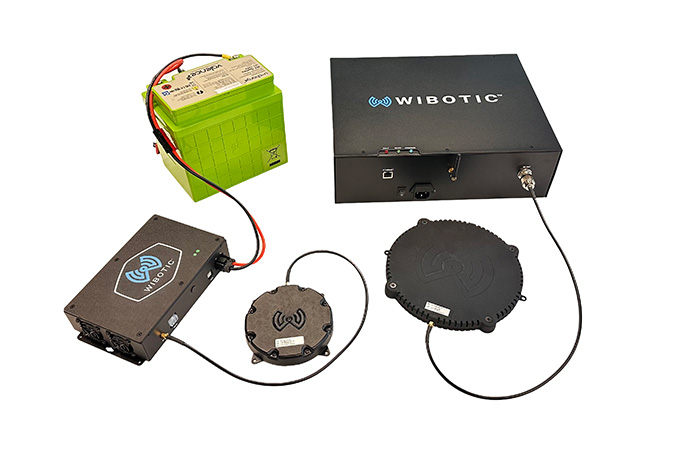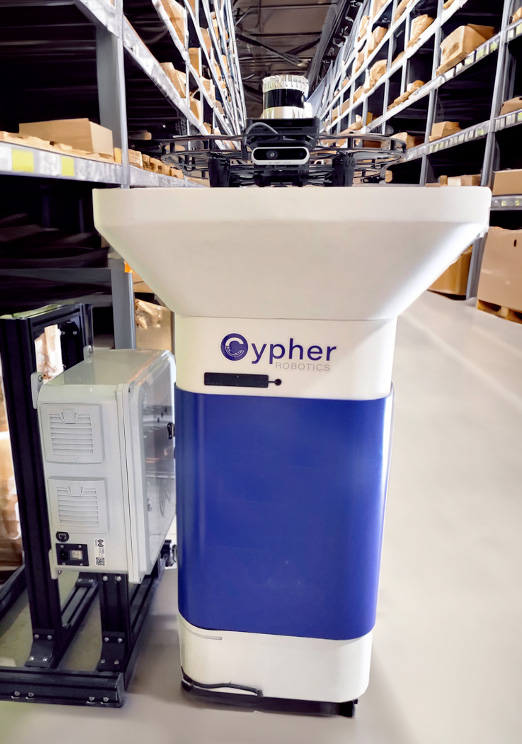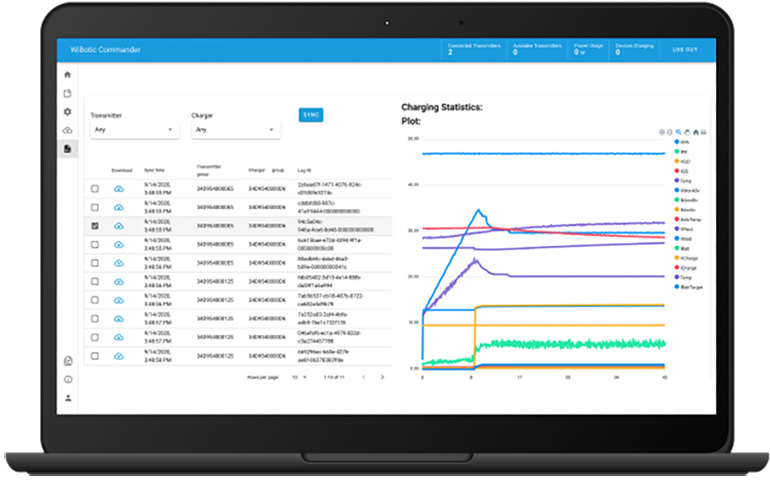|
Listen to this article |

WiBotic 1kW System (battery not included). | Credit: WiBotic
WiBotic today unveiled a new 1kW wireless charging product for larger-capacity battery systems. The Seattle-based company has made a name for itself in the mobile robotics market by providing contactless charging as an aftermarket alternative to OEM contact-based changing systems. The prior product link included 150-watt, 250-watt, and 300-watt wireless charging options.
The new higher-power 1kW system opens a whole new class of machines for wireless charging, said WiBotic. It uses 110v power and a minimum 30 amp circuit, delivering the higher power without the need for three-phase source facility power circuits.
The WiBotic Commander software will manage the charging current based on source power circuit characteristics, so as not to trip a facility power circuit.
WiBotic says contactless charging promises benefits
The advantage of moving from contact charging to wireless charging is twofold, according to WiBotic.
First, with contact charging, systems need to be manually connected and disconnected to the charger, it said. Some automated guided vehicle (AGV) and self-driving vehicle manufacturers provide autonomous contact chargers, but these systems use proprietary connectors.
End users that deploy mobile robots with contact chargers from more than one OEM will ultimately end up with a wall of dedicated charging stations that can only be used by specific robots. This is inefficient and takes up critical facility floor space, the company noted.

Cypher Robotics mobile robot in a warehouse – with integrated drone pad for aerial inventory – docked to WiBotic’s Edge transmitter. | Credit: WiBotic
“WiBotic’s new wireless 1kW charging platform enhances operations,” stated Peter King, vice president of Cypher Robotics Inc., an Ottowa-based provider of warehouse AMRs and drones.
“We’ve successfully deployed WiBotic chargers for customers in a range of applications and in some difficult environmental conditions — but historically only in applications where overnight charging was possible,” he said. “With the new 1kW system, robots will charge at three times the previous speed, opening up a whole new set of applications where fast and ultra-reliable charging is needed.”
The second advantage of wireless charging is in the uniformity of the charging infrastructure, said WiBotic. Any available wireless charger station in a facility can be used by any robot in the fleet in need of a recharge.
Depending on the number of mobile robots in an end user’s fleet, this concept can vastly simplify the charging process, claimed the company. Facility operators can place wireless charging stations at various sites so they can used by any autonomous mobile robots (AMRs).
Wireless communication for operational data
When retrofitting a mobile robot with the WiBotic charging system, a smart charger controller unit needs to be installed onto the AMR. This smart charger autonomously manages the power transfer from the wireless charging pad to the mobile robot unit.
WiBotic has an open API [application programming interface] that enables an AMR to easily communicate with the onboard smart charger.
The smart charger then wirelessly communicates with the powered pad to control the flow of energy wirelessly between the source pad and the onboard power receiver. With the new 1 kW power system, it can transfer more energy, more quickly, to larger mobile robots, said WiBotic.
Using a proprietary wireless communication channel, the onboard charger can also relay statistical information and other data, not only about the onboard battery, but also from the robot controller. This data dump is separate from any Wi-Fi or 5G communication connection to the robot and provides OEMs with another option for data transfer and communications.
Ben Waters, co-founder and CEO of WiBotic, described the smart communication feature:
“This higher-power product allows us to get into markets that aren’t robotic, machines like carton handlers, pallet jacks, and floor-cleaning vehicles. There are a lot of battery-powered vehicles out there today that are not yet robotic or autonomous. They’re just dumb devices in the sense that they are not connected devices, and OEMs don’t have a way to remotely talk to them. By adding wireless charging to their devices, they also now can communicate data from the devices. It can be a simple diagnostic, like: ‘How many hours does my floor scrubber have on it?’”
The company has also developed its own management software, WiBotic Commander. Customers can easily monitor the charging status and battery health of entire fleets of robots in real time. Charging procedures can then be implemented proactively to vary charge current and voltage to dramatically increase battery lifespan.
While end users can purchase and deploy the wireless chargers, WiBotic has focused on building relationships with OEMs and helping to integrate their mobile robot controllers to the WiBotic power controller. The WiBotic controller can also work with contact chargers, providing charge management options for any mobile robot power need.
“We [primarily] work with two types of customers,” said Matt Carlson, vice president of business development at WiBotic. “We work with the OEMs offering the robots as a service, but they’re the company who builds the robot, and then they provide it to the end customer. So with those customers, we work with their engineering teams very closely.”
“In some cases, we work with the end customer, where they might operate multiple robots or different types of carts,” he added. “And for one reason or another, charging is a huge problem for them. It’s a big cost because at the end of every day, some employee has to charge all the batteries on all of the robots, to prepare for the next day.”

The Wibotic Commander software is a ‘single pane of glass’ for managing the charging of a robotic fleet. | Credit: WiBotic
Higher-frequency charging helps prevent inductive heating
Another key feature of WiBotic’s system, according to Waters, is that it uses higher radio frequencies for energy transfer than some of its competitors.
“Some of these inductive systems operate at a lower frequency, typically between 50 and 200 kilohertz,” he told The Robot Report. “WiBotic uses 6.78 megahertz, which is still way below all your Wi-Fi [communication].”
WiBotic said its platform reduces safety risks from electrical shorts and fire risk from sparking across contacts, making it suitable for environments where dirt, dust, water or corrosion can lead to failed charging cycles.
“But there are some important technical advantages, especially at the higher power levels,” said Waters. “One is that we don’t heat foreign objects. Inductive heating systems are also in this range, so if there is some loose metal around, it can heat up [as a side effect]. A lot of [our competitors] have very robust foreign object detection, which is great. This will prevent metal objects from heating up, but it’s going to stop charging.”
“So operating at the higher frequency and adding in some of the things that we do around our adaptive tuning [means] we don’t have this phenomenon of heating metal objects,” he said.
WiBotic plans to demonstrate its new 1kW system at Booth 4087 near the ARM Demo Area at Automate in Chicago next week.
 Learn from Agility Robotics, Amazon, Disney, Teradyne and many more.
Learn from Agility Robotics, Amazon, Disney, Teradyne and many more.





